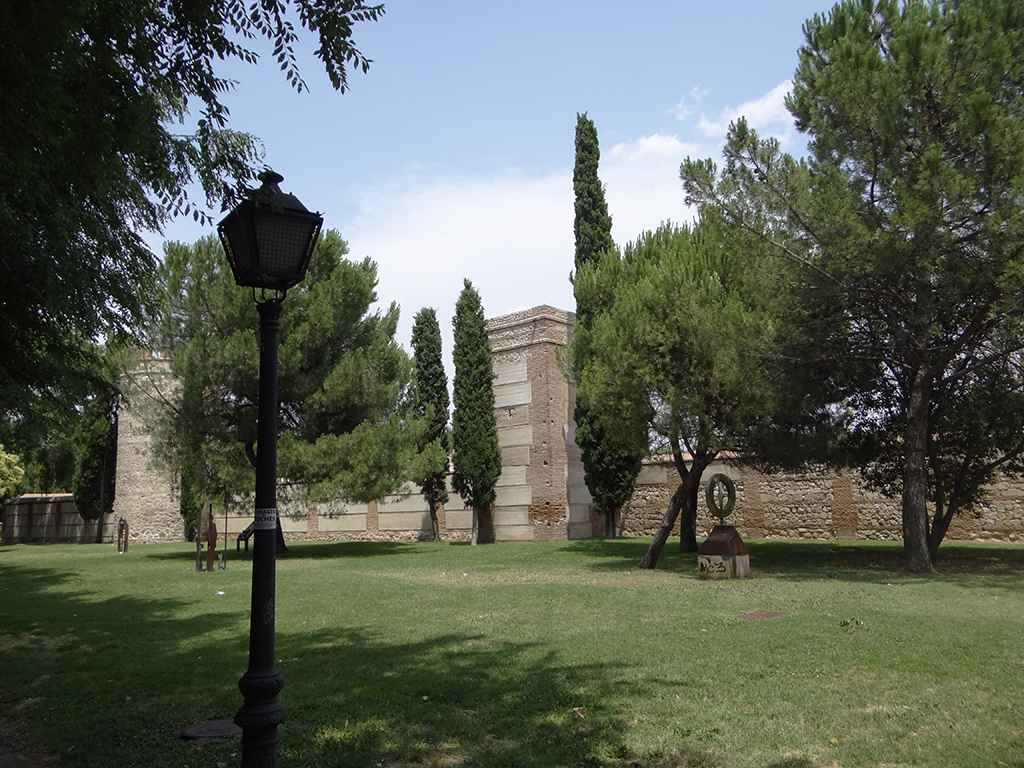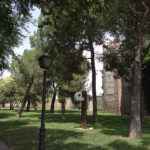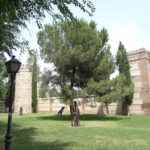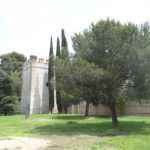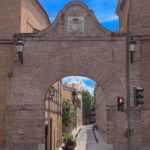Este texto también está disponible en español
Before turning into Alcalá de Henares, the existence of Burgo de Santyuste is still tangible through the walls surrounding the Archbishop’s Palace. Some of the sixteen towers of the walled enclosure that covers several acres of land are able to visit and will transfer you back in time eight hundred years.
If you choose road Complutense to access Alcalá de Henares, you will get directly into the city center, and the first thing you will met, as if it was a postcard in motion, is the Alcalá’s walled enclosure, that is, the Mediaeval city walls, with its towers along its length, all square shape but one.
As Alcalá was a precious place to conquer, first by Arabs and then by Christians to regain, always counted on a walled enclosure. Arabs constructed then a fortified castle on the west side of the Ecce Homo hills, while Christians—who transferred the village to Toledo Archbishop in 1126—under the command of Rodrigo Ximénez de Rada archbishop, constructed a military fortress in 1209 after several Muslim raids against Madrid and Alcalá in 1197. The fortress was afterwards turned into the current Archbishop’s Palace.
The Alcalá’s twenty-two turrets
Though Alcalá’s walled enclosure used to surround the mediaeval village, today, just the wall around the Archbishop’s Palace is maintained. In the Anton Van Den Wyngaerde drawing, a Flamish landscape of 1565, more than twenty towers are observed along the walls.
The city was completely guarded within the mediaeval walled enclosure until the end of nineteenth century, when an expansion to Alcalá was undertaken adding places such as: a train station and its rails, a great public park, a cemetery and several small palaces like the famous Laredo’s Palace, situated in what today is known as the Station Promenade.
Even the mighty fall…
In the fourteenth century, walls were reinforced by Pedro Tenorio archbishop, whose coat of arms is still kept in three of the wall’s turrets. The prettiest turret carries his name, situated at the east wing of the wall, separates the plaza de las Bernardas from the Archbishop’s Palace. It is decorated with loopholes and machicolations recalling its defensive origin. It also has, due to the refurbishment undertook by Manuel Laredo, a curious nineteenth-century balcony from Tudor period style that links to the council hall.
Don Pedro surrounded Archbishop’s Palace enclosure and its wall and twenty-two turrets—from which just sixteen remain—some of them with Alcalá’s inhabitants gravestones such as those present in front of that of Tenorio Archbishop.
Inside the Archbishop’s Palace walled enclosure, the old Bishop’s Vegetable Garden—or albácar—took place. The enclosure was a breeding and enjoyment place to the archbishop’s court and also a shelter for civil or military population in case of warfare.
The seven doors’ city
Tenorio archbishop also extended the so-called village fence and made it accessible by seven entrances. North of the wall, the Burgos door was placed inside the Bernardas Cistercian monastery, today moved to the current Saint Bernardo Arch. The west showh the Madrid, Santa Ana or del Postigo doors. On the south, you may find the Vado door, in the present plaza del Empecinado. The east side holds three doors, that is, Fernán Falcón—or Tenerías Viejas—, Guadalajara and Postigo de los Judíos doors, placed respectively at the end of calle Santa Úrsula, at the end of calle Mayor and at calle Santiago.
In the middle of fifteenth century, the Alonso Carrillo de Acuña archbishop built the second wall in order to protect the new hamlet established outside the old village walls, including the market (today plaza de Cervantes) and the Franciscan monastery founded by him and known as San Diego monastery.
Thus, the Santa Ana door was moved to the square with the same name and a new door, at the north of the first is open, the Nueva door located at plaza de Atilano Casado. Besides, two additional doors are accessible on the east side: Guadalajara door—now called Mártires door—, and Aguadores door, in the roundabout with the same name.
The southern wall was also extended so Vado door was moved to its current emplacement and an additional was opened: San Julián door, at the end of the so-called street. It is suspected that another entrance near to the corner between Carmen de Calle Descalzo and Santo Tomás de Aquino was constructed.
Madrid and Spartacus doors
The original Madrid door disappeared and was reconstructed by the architect Antonio Juana Jordán in 1778, by order of the Cardinal and Toledo’s Archbishop Francisco Antonio Lorenzana. The door has a neoclassical style influenced by Madrid’s Puerta de Alcalá. The inscriptions of the building mention the cardinal himself, the architect and the date it was reconstructed “during the reign of Charles III”.
Additional information:
Useful information:
- Address: Plaza Puerta de Madrid.
Access from Madrid
- Renfe Cercanías railroads C-1, C-2 and C7A.
- Bus nº 223 (departure from Avenida de América Interchanger).
Image gallery:
On video:
Where is it
Sigue disfrutando de Dream Alcalá:
- Telegram: Recibe nuestras noticias y contenido exclusivo (clic aquí).
- Newsletter: Recibe cada tarde un correo con nuestras últimas noticias (clic aquí).
- YouTube: Suscríbete para ver nuestros mejores vídeos (clic aquí).
 Sé tú el periodista: envíanos tus fotos o noticias a través de Telegram.
Sé tú el periodista: envíanos tus fotos o noticias a través de Telegram.

